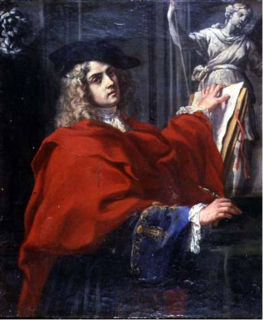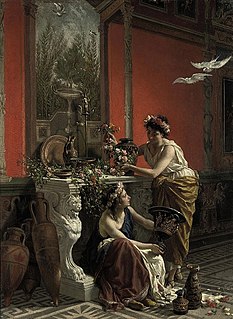Related Research Articles

Cesare Arzelà was an Italian mathematician who taught at the University of Bologna and is recognized for his contributions in the theory of functions, particularly for his characterization of sequences of continuous functions, generalizing the one given earlier by Giulio Ascoli in the Arzelà–Ascoli theorem.

Giulio Ascoli was a Jewish-Italian mathematician. He was a student of the Scuola Normale di Pisa, where he graduated in 1868.

Pier Leone Ghezzi was an Italian Rococo painter and caricaturist active in Rome.

Nicola Filotesio was an Italian painter, architect and sculptor of the Renaissance period, active primarily in or near the town of Ascoli Piceno.

Giuseppe Ghezzi was an Italian painter of the Baroque period, active mainly in Rome.

Cesare Mariani was an Italian painter and architect of the late-19th century, active in Rome and Ascoli Piceno.

Ludovico Trasi was an Italian painter of the Baroque period, born and active in Ascoli Piceno.
Vincenzo Pagani was an Italian painter of the Renaissance period.
Domenico Falco is an Italian former professional footballer who played in Serie B for Ascoli.
Agostino Collaceroni was an Italian painter, mainly active in his native Bologna as a painter of quadratura. He trained under Andrea Pozzo. For the church of Sant'Angelo Magno of Ascoli Piceno, he painted quadratura for which Tommaso Nardini painted the figures.
Tommaso Nardini was an Italian priest and painter of the Baroque period, active in his native town.
Vincenzo De Mita was an Italian painter, mainly depicting sacred subjects.
Biagio Miniera was an Italian painter, active in a Rococo style.
Giuseppe Giosafatti (1643–1733) was an Italian architect and sculptor, mainly active in the city of Ascoli Piceno.
Giuseppe Angelini, known as la Regina was an Italian painter.
Agostino Castellacci was an Italian painter of the Baroque period.
Cassa di Risparmio di Fermo S.p.A. (Carifermo) is an Italian savings bank based in Fermo, Marche region.
Pier-Sante Cicala was an Italian painter of the Baroque period, born and active in Ascoli Piceno. After dallying with priesthood, he became a painter, manuscript illuminator, and architect. He trained in the former with Ludovico Trasi. He learned military architectural designs from Captain Celso Saccoccia. He painted both sacred subjects and still lifes.
Giorgio Di Genova is an Italian art historian, critic and curator, mostly known for being the author of History of Italian Art of the Twentieth Century.

Andrea Benetti is an Italian painter, the author of the Manifesto of Neo Cave Art presented in 2009, at the 53rd Venice Biennale, at the Ca' Foscari University.
References
- ↑ Il Raccoglitore Ossia Archivi Di Viaggi, Di Filosofia, D'Istoria, Volume 46, by Davide Bertolotti, page 530.
- ↑ Descrizione Delle Pitture Sculture Architetture ed altre cose rare Della Insigne Citta delle Ascoli nelle Marca; by Baldassarre Orsini, Stamperia Baduelliana, Perugia, 1790. page 239-240.